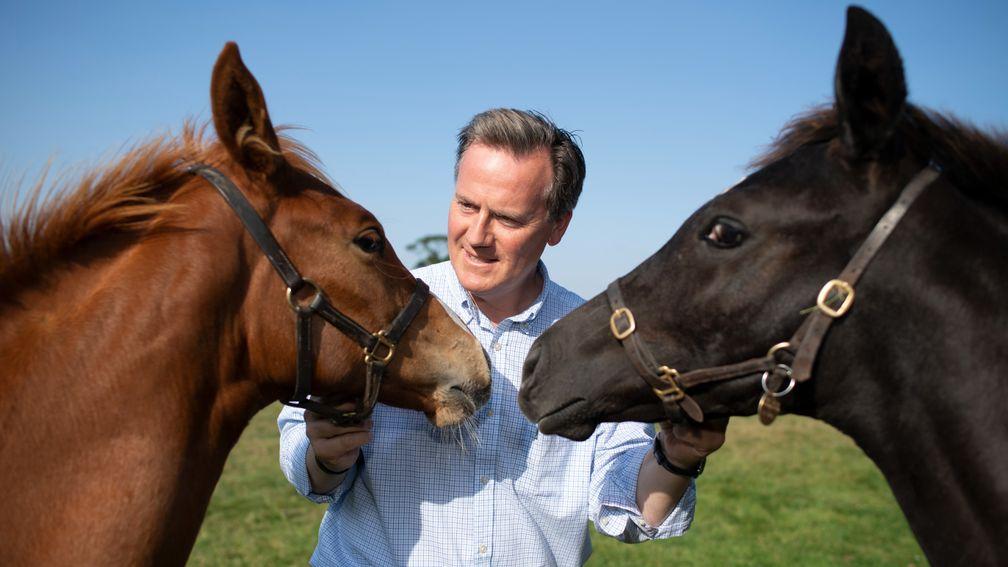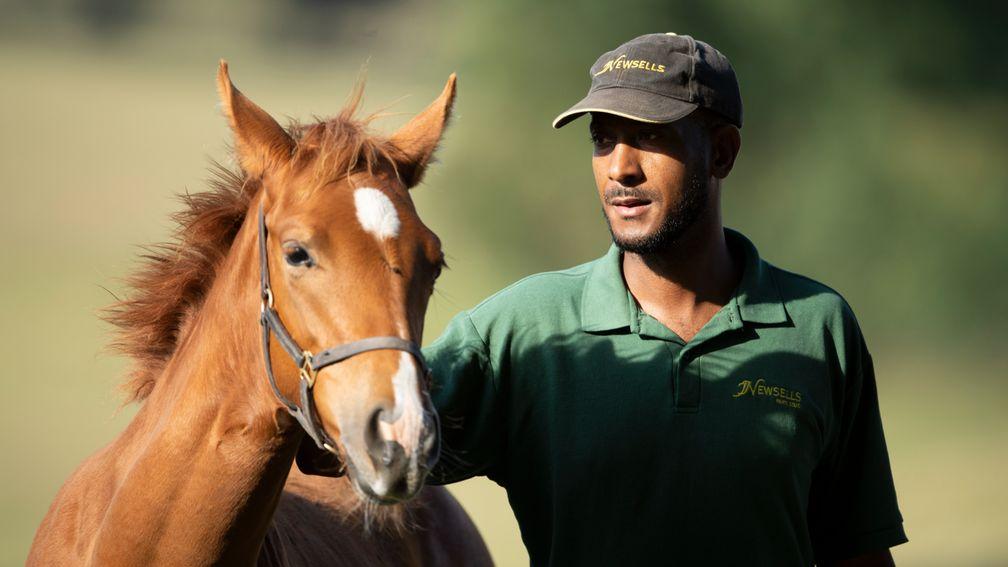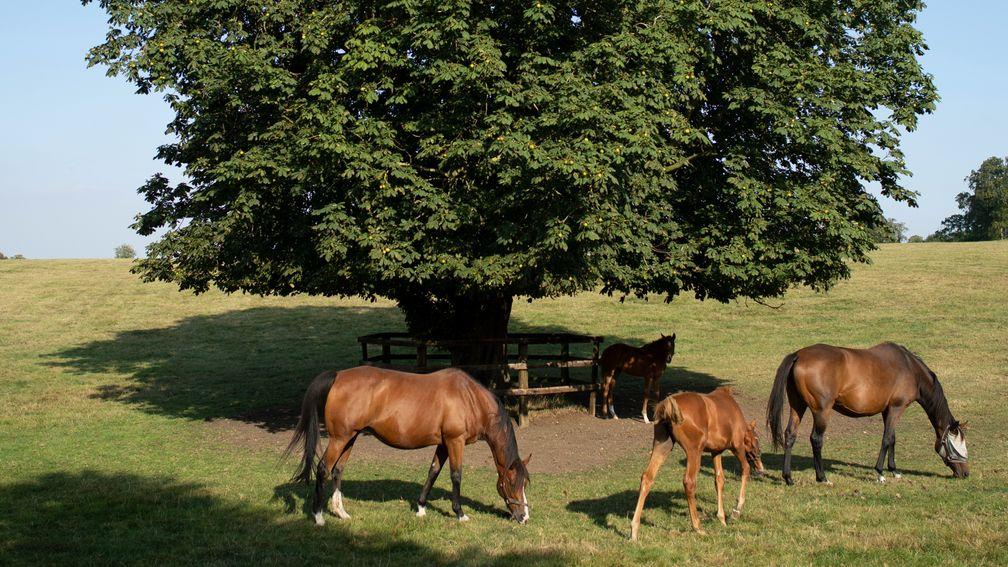'If I was a horse living in a paddock like this, I'd think life was pretty good'

For National Racehorse Week, the Racing Post has visited racehorses at five different stages of their lives. In part one, Julian Muscat went to Newsells Park Stud to see how foals are reared and nurtured.
It is as idyllic as it gets. On a sunny September afternoon six broodmares and their foals meander around an undulating paddock at Newsells Park Stud, one of Britain's premier breeding nurseries near Royston in Hertfordshire.
The mares are relaxed. They have been nourishing their foals for more than four months. In truth, they are keenly anticipating the day when their foals are weaned away from them and required to fend for themselves.
The foals themselves are of an age when they no longer stick closely by their mother's side. They are gaining independence and indulging their sense of adventure. It isn't long before they gather around us, their inquisitive noses prodding at the cuffs of our shirt sleeves, curious to absorb the aromas unique to all human beings. In the years ahead their sense of smell will be integral to the bond they will form with the staff who look after them.
The foals are also relaxed, especially on this warm afternoon spent grazing and sunbathing on the lush pasture. Stud farms such as this are where the two-year-old crop of 2023 are born and raised. They are nourished and cared for like no other species of animal. They want for nothing, not least the care bestowed on them by devoted staff.
"If I was a horse living in a paddock like this, I'd think life was pretty good," says Julian Dollar, general manager at Newsells Park since 2006. "Our job is to give them the best possible environment to help them grow and develop into the best athletes they can be."
Dollar has chosen one particular foal for us to contemplate at length. He is a chestnut colt by Waldgeist, whose haul of four Group 1 triumphs included the 2019 Prix de l'Arc de Triomphe, in which he overhauled Enable by a length and three-quarters.
Waldgeist was bred jointly by Newsells Park and Ammerland Stud, and raced by them in partnership. The foal is from Waldgeist's first crop; there is keen anticipation about how he will fare as a stallion.
This particular foal makes a fine advertisement for Waldgeist. He has good, clean limbs that have required no attention since he was foaled on April 19. This is not always the case: some foals are born with problems which, if left unattended, will compromise their ability to achieve their full potential.
"It was a straightforward foaling," Dollar recalls. "When he was foaled we ran a very thorough assessment and series of checks on him, together with our vet. After 24 hours we took some blood tests to make sure everything was as it should be. And when all of that came back fine, we turned the mare and foal out together in a small paddock so that they could create a bond between them, which is very important."

The Waldgeist foal is out of Date With Destiny, who is unique in herself. She is the only horse ever sired by George Washington, the 2,000 Guineas and Queen Elizabeth II Stakes winner who spent one truncated season at stud when his fertility all but failed him. The only live foal born from that brief stint was Date With Destiny.
A winner and Listed-placed on the track, Date With Destiny was bought by Newsells Park at the end of her racing days for 185,000gns. Her best produce to date is Beautiful Morning, a Group 3 winner by Galileo.
Since Waldgeist is by Galileo, it made sense to mate Date With Destiny with Waldgeist to replicate a previously successful formula. The chestnut foal grazing happily alongside his mother at Newsells Park today is a three-parts brother to Beautiful Morning, and thus a valuable asset.
Valuable or otherwise, all foals at Newsells Park receive the same attention from the day they are born, raised in optimum conditions and cared for with the same commitment parents make to their own children. In so far as finances permit, nothing is spared.
"We are spoiled rotten here," says Dollar. "Newsells Park is a beautiful stud with wonderful land on which to raise horses. A Derby winner [Parthia in 1959] was bred here before we came, and we have bred a dozen Group 1 winners in the last ten years. But what makes us so very lucky is that I have a great team working with me. They are dedicated; they take a lot of pride in their work."
After Date With Destiny and her Waldgeist foal grazed alone for the first two weeks, they were introduced to another mare with a foal of the same age in a slightly bigger paddock.
"We created a group of four," says Dollar. "After that, another mare and her foal were introduced to the group, again in a bigger paddock, and that group formed their own bond. The idea is that the foals become friends."
This is an integral aspect of rearing foals. Horses are creatures of flight. Any change in their circumstances can put mares and foals on edge, which could easily prompt them to gallop flat out across the paddock.
"We want them to gallop around to help their development but we want them to do it in the safest possible way," explains Dollar. "We don't like it if a mare gets stressed and gallops about with her foal shouting behind her, straining hard to keep up. Foals that have to come into a box with problems or growth issues become headaches.
"The ones that don't need much interference are the ones that tend to do the best [as racehorses]. We want them to canter around over the undulations, going up and down hills to develop their muscles, but in a controlled way.
"Once the foals start living out in the paddocks all the time, they just fly. They rarely have problems and Mother Nature does the work for you. When a foal is doing well the best thing is to leave it alone and interfere as little as possible."
The policy at Newsells Park is for the stock to stay out in the paddocks for as long as possible, until the weather dictates otherwise.
"To have the horses out for 20-22 hours a day, as opposed to six or seven if they were brought into boxes overnight, must be a good thing," argues Dollar.
"As they get older they come in during the day for two or three hours to be fed and handled. Until then, we try to let them be horses. It must be good for them to move around and gallop about, although in my experience thoroughbreds seem to spend all day trying to find ways to hurt themselves."
A seminal moment in any foal's life arrives when it is weaned – usually when it is five months old. Again, reducing levels of potential stress is the key. At five months most foals have gained a degree of autonomy from their mothers and mingle freely with one another.
The weaning process is long established at Newsells Park. Two mares are quietly withdrawn from the paddock and are out of sight before their foals realise it. When they do, the foals might call out while running around in search of their mothers. However, they soon settle down to a life of grazing without access to their mother's milk. Before long all the mares are withdrawn to leave a paddock full of weanlings.
The weanlings are now fully independent, but not without assistance. That comes in the shape of the stud's staff, who keep a close eye on them throughout the day. Two of them, Carey Plummer and Brittany Rushworth, are barn leaders with responsibilities for weanlings that graze the pasture until December.
Plummer, who is of Jamaican descent, arrived in England aged eight to join his mother, who settled here 30 years ago. As a young child he spent much of his time at the racetrack in Jamaica.
"I got a buzz from it," reflects Plummer. "I tried to become a jockey but I was too tall, too heavy. I was always fascinated by pedigrees and came to Newsells Park more than four years ago from Crimbourne Stud. Before that I completed the Diploma Course at the National Stud [in Newmarket]."
Plummer's laid-back temperament is ideal for interacting with weanlings, who can feel a little vulnerable immediately after weaning.

"When you come in to work every morning the horses take away every stress you feel in a natural way," he says. "If the weanlings start to play up I will spend a bit more time with them, handling them. You have to get into their minds very early. The more you handle them, the better they are.
"It makes it much easier for them when they go into training if they are well mannered and used to people. If you treat them with respect, they will do the same to you. Bad people ruin horses."
This, then, is how foals are raised ahead of their racing days. They want for nothing. Their growth patterns are closely monitored, their diets adjusted according to their stage of development. They are fed twice a day to complement their grass rations, and in Plummer and Rushworth they have counsellors on site 24/7.
"We need somebody permanently on hand to keep an eye on the weanlings," says Plummer. "There are between 50-60 of them in all, so it's a responsible job."
Spread the word and let's all make sure National Racehorse Week is here to stay
As the year draws towards its end, the weanlings will have run together in small herds. The colts and fillies will have been separated and the herds will stay intact for the next few months.
"The consistency of the groups is very important," says Dollar. "We don't want them getting upset because they have lost their mates, so we keep the friends together in their groups."
In December the groups are transferred to the west side of Newsells Park, where the pasture, with its lighter soil base, is more suitable for winter grazing. Most of the staff will make the same migration. On January 1 the weanlings become yearlings. They remain out at grass until spring, when they start being prepared to enter training. Before they do, most of them will head for the yearling sales.
Newsells Park is first and foremost a commercial operation. It was run as such by the Jacobs family since Klaus Jacobs bought the property in 2000. The stud changed hands in June, when it was purchased by Graham Smith-Bernal, who intends to continue in a similar vein.
The yearlings make for the sales next month, after which a new crop of weanlings is waiting to take their place in a process that is renewed every year.
It is an annual ritual involving the highest standards of care, and which provides the seed corn for racing. For young thoroughbreds, it's very much a case of to the manor born.
Read part two of our National Racehorse Week series, looking at two-year-olds with George Boughey and Oscula, from 6pm on Monday. If you would like to take part in the many events of National Racehorse Week go to nationalracehorseweek.uk for more details.
Members can read exclusive interviews, news analysis and comment daily on racingpost.com. Click here to sign up

Over 50% off Racing Post Members' Club!Members' Club is the only subscription racing fans and punters need in order to stay informed and make smarter betting decisions. Features include early access to the Racing Post digital newspaper, exclusive news and interviews, premium tips and form study tools to assist with betting. Select 'Get Ultimate Monthly' and enter code TRYME to get your first month for just £14.99* – that's better than half price!
If you decide that Members' Club is not for you, then you can cancel at anytime by contacting us.
*Members' Club Ultimate Monthly first month will be charged at £14.99, renews at full price thereafter
Published on inSeries
Last updated
- We believed Dancing Brave could fly - and then he took off to prove it
- 'Don't wind up bookmakers - you might feel clever but your accounts won't last'
- 'There wouldn't be a day I don't think about those boys and their families'
- 'You want a bit of noise, a bit of life - and you have to be fair to punters'
- 'I take flak and it frustrates me - but I'm not going to wreck another horse'
- We believed Dancing Brave could fly - and then he took off to prove it
- 'Don't wind up bookmakers - you might feel clever but your accounts won't last'
- 'There wouldn't be a day I don't think about those boys and their families'
- 'You want a bit of noise, a bit of life - and you have to be fair to punters'
- 'I take flak and it frustrates me - but I'm not going to wreck another horse'